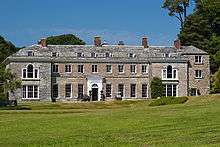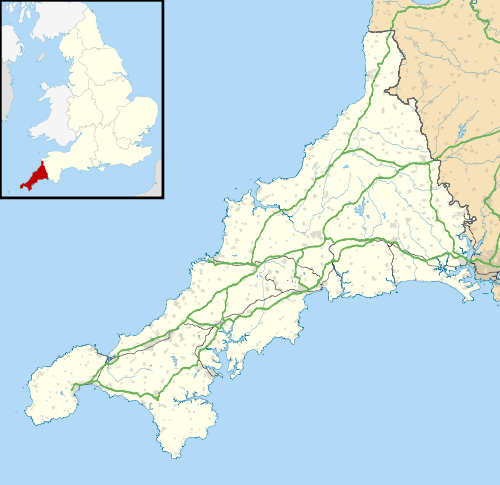Boconnoc
Coordinates: 50°24′58″N 4°36′40″W / 50.416°N 4.611°W
Boconnoc (Cornish: Boskennek) is a civil parish in Cornwall, England, United Kingdom, approximately four miles east of the town of Lostwithiel.[1] According to the 2011 census the parish had a population of 96.
The parish is rural in character and is fairly well wooded. It is bordered to the west by St Winnow parish, to the south by St Veep parish, to the southeast and east by Lanreath parish, and to the north by Broadoak parish.[2] The hamlets of Couch's Mill and Brooks are in the parish.[3] Part of ancient deer park at Boconnoc House contains an internationally important assemblage of lichens and is one of the most important sites in Europe for lichens.[4]
History
Boconnoc is mentioned in the Domesday book as Bochenod. The first known owners were the De Cant family in 1268.[5]
The present Bocconoc House was built on the site of a medieval house owned successively by the families of Carminow and Mohun. Lord Mohun's widow sold the estate to Governor Thomas "Diamond" Pitt, a wealthy trader who had made a fortune in India. Pitt founded a political dynasty that included numerous MPs, including his grandson William Pitt and great-grandson William Pitt the Younger. After Governor Pitt's death in 1726 the estate passed to his son Robert Pitt and then the following year to his son Thomas Pitt. In the Return of Owners of Land survey of 1873 Mr Cyril Fortescue of Boconnoc was listed in the top ten landowners in Cornwall with an estate of 20,148 acres (81.54 km2), or 2.65% of Cornwall.[6]
The country estate is steeped in history and includes the largest landscaped park in Cornwall. It is home to a cricket team who play in Deer Park. In 1993, the estate was used as a location for the film The Three Musketeers.[7][8]

A chapel stood in the hamlet of Trecangate between 1820 and 1954. It was built using cob walls; a sign marking its position was erected in 2009. [9]
Anthony Fortescue, owner of Boconnoc and High Sheriff of Cornwall, was found dead on the 9 November 2015 following a firearms incident which is not being treated as suspicious.[10]
Boconnoc House and estate

Boconnoc House (Grade II* listed[11]) was built in the 18th century by two members of the Pitt family: one wing was built ca. 1721 by Thomas Pitt, Governor of Madras, and the other in 1772 by Thomas Pitt, 1st Baron Camelford. The two wings formed an L-shape and the grounds are finely landscaped: on a hill behind the house is an obelisk in memory of Sir Richard Lyttelton (1771). During the 19th century the estate passed into the ownership of the Fortescues who made some alterations to the structure in 1883: there are some more recent additions and the south wing was demolished in 1971. The parish church is behind the house and fairly small: it contains an interesting 15th-century font and a monument to Penelope Mohun, 1637.
The estate, surrounding the River Lerryn, contains a deer park, lake, agricultural land and woodland. Parts of the estate are designated as Boconnoc Park Important Plant Area and Boconnoc Park & Woods Site of Special Scientific Interest, noted for its biological characteristics.[12][13]
Wildlife and ecology
Old-growth, sessile oak (Quercus petraea), growing in ravines and slopes in parts of the ancient deer park at Boconnoc House, contain an internationally important assemblage of lichens, making it one of the most important sites in Europe. The site is also considered to be the best ″old-growth, southern-oceanic oak woodland″ in the south-west.[4]
See also
References
- ↑ Ordnance Survey: Landranger map sheet 200 Newquay & Bodmin ISBN 978-0-319-22938-5
- ↑ Cornwall Council online mapping Archived 5 May 2010 at the Wayback Machine.. Retrieved May 2010
- ↑ Cornwall; Explore Britain
- 1 2 Sanderson, Neil A (December 2014). "Wildlife Reports - Lichens". British Wildlife. Nick Wright. 26 (2): 139–40. ISSN 0958-0956.
- ↑ "Boconnoc". GENUKI.
- ↑ Who Owns Britain – by Kevin Cahill
- ↑ IMDB movies with location Boconnoc
- ↑ The History of Boconnoc House in Cornwall
- ↑ "Researcher discovers family links with long gone chapel". thisiscornwall.co.uk. 16 February 2009. Retrieved 4 October 2009.
- ↑ Morris, Steven (10 November 2015). "High sheriff of Cornwall found shot dead on estate". the Guardian. Retrieved 2015-11-12.
- ↑ Historic England. "Boconnoc House (Grade II*) (1140354)". National Heritage List for England. Retrieved 15 October 2015.
- ↑ "Boconnoc Park". Plantlife. Retrieved 7 February 2012.
- ↑ "Boconnoc Park & Woods" (PDF). Natural England. 14 November 1986. Archived from the original (PDF) on 24 October 2012. Retrieved 26 October 2011.
Further reading
- Betjeman, John (April 1933) "Two Cornish houses: Glynn; Boconnoc", in: Architectural Review (reprinted in Betjeman's Britain; selected, edited and introduced by Candida Lycett Green. London: John Murray, 1999; pp. 43–51)
- Lysons, Daniel & Samuel, Magna Britannia, Vol.3, Cornwall, London, 1814, pp. 24-38
- Gilbert, Davies, (ed.), The Parochial History of Cornwall: Founded on the Manuscript Histories of Mr Hals and Mr Tonkin, Volume 1, London, 1838, p.63
External links
| Wikimedia Commons has media related to Boconnoc. |
